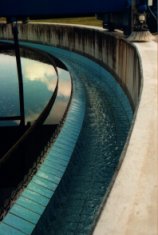C-N-P
concept; advantages
Stable output values
All sewage treatment plants that started to work with the C-N-P
Concept achieved independent of the input values significant improvement of the
removal rates and also saw a stabilization on the long term. Therefor the chance
of exceeding the maximum allowable concentrations is reduced to a minimum. Also
the amount of rest water diminished.
Less oxygen / energy required
Often the required amount of oxygen cuts down to 50 % because
of the controlled oxidation resp. oxygen limitation in the biologic stage. The
air consumption is proportional to the compressor power; which takes 50 % of the
power of the complete sewage treatment plant. This means a big savings potential.
Less residual sludge
The C-N-P Concept creates a selection pressure to the micro-organism
population, which favors the long living species. These use most of the substrate
for their own preservation (nutrition) than the short living species. Last ones
use the substrates mostly for multiplication. As
a result of this the amount of residual sludge goes down, giving a series of different
savings. First one needs less chemicals for de-watering. Second needs to deposit
less residual sludge (mass reduction) = reduction of deposit costs. Last the working
hours of the de-watering machines go down, increasing the life time and reducing
the required energy.
Maximizing the energy regain
The amount of the Methane-gas from the gasifying increases, giving
a better utilization of the present C-resources.
 No
need for complex de-nitrification stages
No
need for complex de-nitrification stages
When using the C-N-P Concept it is possible to reach the required
N-elimination in installations without de-nitrification zones. Under
circumstances it might be possible to eliminate or at least postpone big investments.
Better utilization of the basin volume
The basin volume can be used more efficiently by using the Pro-Entec
high-grade chemicals. The dosing functions like a switch, that can enlarge or
reduce the basin volume to demand. Especially installations with a temporary or
chronic overload have a good opportunity to avoid or postpone expensive expansions.
In this and the fact that there is no need for a separate de-nitrification
are the possibilities for the biggest savings.
 No
need for complex de-nitrification stages
No
need for complex de-nitrification stages